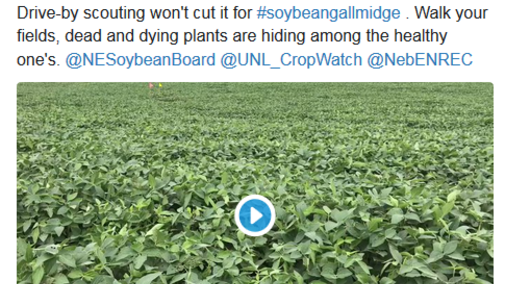Follow UNL_CropWatch on Twitter to stay up to date on Nebraska Extension pest and crop reports throughout the week.
Drive-by scouting won't cut it for #soybeangallmidge . Walk your fields, dead and dying plants are hiding among the healthy one's. @NESoybeanBoard @UNL_CropWatch @NebENREC pic.twitter.com/UYgAjMGjeB
— Justin McMechan (@justinmcmechan) July 31, 2019
Why terminating cereal rye #cover crop at right time is important? @UNL_CropWatch @UNLExtension pic.twitter.com/vG4paebpuN
— Amit Jhala (@AmitUNL) August 1, 2019
And there's a lot of Physoderma Brown Spot in Nebraska #corn this year following frequent rainfall earlier this season. Small dark spots on leaf sheath, leaf midrib & stalk can also occur. Sometimes spores accumulate & infect around the stalk making it brittle & prone to breakage https://t.co/Kggf4B4G8l pic.twitter.com/YPy51rXFnR
— Tamra Jackson-Ziems (@tjcksn) July 31, 2019
Todd Whitney, Extenstion Educator in Phelps County: Although wheat harvest was delayed about two weeks compared to normal and some fields received significant hail injury, overall yields are strong. Yields ranged from 60-80 bu/ac on continuous wheat acres with rotated wheat acres, irrigated pivot and corner pivot acres yielding up to 90 – 115 bu/ac. Test weights have also been good. Corn prospects range from strong to some concerns about later fields just tasseling this week. Corn planted May 10 will likely reach black layer around Oct. 1; while corn planted May 20 will likely reach full maturity (black layer) around Oct. 19. This is about one month later than 2018. Lots of aerial spraying this week for controlling western bean cutworm and some fungicide spraying for gray leaf spot. Soybeans are good but yield prospects may not be quite as good as 2018 due to delayed development. (8/2/19)
John Thomas, Extension Educator in Box Butte County: Wheat harvest is just starting in this area, 10 days to two weeks behind normal. We had plenty of moisture earlier in the season and the wheat looks good. The fly in the ointment now may be the sawfly in the wheat stem. While there were some significant catches of wheat stem sawfly wasps earlier, we’re waiting to see if that translates into significant lodging and crop loss. While we could use the moisture to nurture along the 100,000+ crop acres without irrigation due to the canal failure, strong thunderstorms with hail and high winds could flatten wheat that’s been weakened by insect damage, making it difficult to impossible to harvest. Sugar beets are also about two weeks behind normal growth and tonnage. An early frost won't kill them, but it could affect tonnage and sugar content. With all the rain earlier in the summer, it’s been a challenge to dry and put up high quality hay. (8/1/19)
John Wilson, Extension Educator in Burt County: Conditions are dry and we desperately need some significant rain. Most crops are still looking pretty good, although just a week and a half ago, corn leaves were curling with the high temperatures and lack of moisture. Most corn is tasseling and soybeans are blooming. Cool-season pastures are starting to show more stress than usual for this time of year. The first wave of thistle caterpillar feeding is over, but now we have a lot more painted lady butterflies (the adult stage of the caterpillar) and are seeing some Japanese beetle feeding. Corn fields are being sprayed with fungicide and some bean fields that haven’t canopied yet (and may not this season) are being sprayed with herbicides. (8/1/19)
Randy Pryor, Extension Educator in Saline County: Most of our corn that had an April planting date is in the milk stage while corn planted in early May is in the blister stage. Crop condition with irrigated and dryland corn remains good to excellent. Pivots were fired up on corn and soybeans this week. Moisture at the 2-4 foot level remains good. Southern rust was confirmed this week by UNL plant pathology in Gage, Jefferson, Saline and Seward counties from samples crop consultants submitted to me. The disease remained at low incidence this week, but there is concern with the predicted forecast of rain, humidity and temperatures in the 80s. Scout your fields carefully and check your seed company for hybrid resistance to southern rust. There aren’t many that have good resistance. Soybean condition is varied throughout the area due to planting date issues. Quite a few non-dicamba trait fields in the area are showing dicamba cupping symptoms. In counting nodes, two timeframes stick out for possible drift occurrences: July 1-5 and July 9-11. There are many reasons for the drift, including sprayer contamination, suspected off label applications (wind bellowing to adjacent sensitive beans during application), and potential air inversion events. Many of these fields should have good outcomes but you won’t know for sure until harvest time. (8/1/19)

